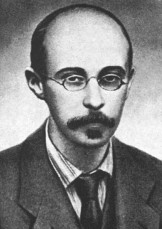
|
|
Alexander Friedmann was a Russian cosmologist and mathematician, who helped develop models that explained the development of the universe. In particular, his solutions to Einstein’s field equations provided early evidence of an expanding universe, and the theoretical underpinnings for both the Big Bang and steady state models of the universe. Alexander (or Aleksandr) Alexandrovich Friedmann (or Friedman) was born on 16 June 1888 in Saint Petersburg, Russia. His father was a ballet dancer and his mother was a pianist. He was an excellent scholar, both in high school at the Second Saint Petersburg Gymnasium, and then at Saint Petersburg State University, where he studied mathematics from 1906 to 1910. He also attended Paul Ehrenfest’s modern physics seminars there, in which quantum theory, relativity and statistical mechanics were all discussed. He was awarded his master's degree in pure and applied mathematics in 1914, although his research had also touched on aeronautics, the magnetic field of the earth, the mechanics of liquids and theoretical meteorology. In 1913, he was appointed to a position in the Aerological Observatory in a suburb of Saint Petersburg, where he studied meteorology. The next year, he went to Leipzig to study with Vilhelm Bjerknes, the leading theoretical meteorologist of the time. He took part in several flights in airships to make meteorological observations, but when the First World War started later that year, Friedmann volunteered to serve with the Russian air force as a technical expert and as a bomber pilot. After 1915, he lectured pilots on aerodynamics, and in 1916 he became the head of the Central Aeronautical Station in Kiev, before moving to Moscow with the Central Aeronautical Station. The Central Aeronautical Station, however, disbanded after the Russian Revolution of 1917 and, from 1918 to 1920, Friedmann worked as a professor of theoretical mechanics at Perm University. Friedmann returned to Saint Petersburg (then renamed Petrograd) in 1920, after the Red Army occupied Perm and the civil war made life there too difficult, to take up a post at the Main Geophysical Observatory. He also took up several other concurrent appointments: as a teacher of mathematics and mechanics at Petrograd University, as a professor of physics and mathematics at Petrograd Polytechnic Institute, and as a researcher at the Petrograd Institute of Railway Engineering, the Naval Academy and the Optical Institute. By late 1920, he had belatedly become familiar with Albert Einstein’s General Theory of Relativity, which was published several years late in war-torn Soviet Russia. In 1922, he discovered the expanding universe solution to Einstein’s general relativity field equations. At first, Einstein thought that the solution was erroneous, but he later agreed that they were in fact correct, and indeed that they shed new light on the whole subject. The expansion of the universe was finally corroborated several years later by Edwin Hubble's observations in 1929. Friedmann’s papers from 1924 demonstrated all three Friedmann models (describing positive, zero and negative curvature of space-time), a full decade before Howard Percy Robertson and Arthur Geoffrey Walker published their analysis. This dynamic cosmological model of general relativity would come to form the standard for the Big Bang and steady state theories of the universe (Friedmann's work supports both theories equally), although the steady state theory was later largely abandoned after the detection of cosmic microwave background radiation in 1965. In 1923 and 1924, Friedmann had the opportunity to travel through Europe, discussing his areas of research with other scientists, particularly in Germany, Norway and the Netherlands. In 1924, he returned once more to Saint Petersburg (by then renamed yet again as Leningrad), where he was given the job of director of the Main Geophysical Observatory in Leningrad. During this time, the prominent Russian theoretical physicist and cosmologist George Gamow briefly studied under him. In July 1925, he participated in a record-setting balloon flight, reaching an elevation of 7,400 meters. However, within two months of this, on 16 September 1925, Friedmann’s life was tragically cut short at the young age of 37, and he died from typhoid fever which it is thought he contracted during a vacation in Crimea. Alexander Friedmann BooksSee the additional sources and recommended reading list below, or check the physics books page for a full list. Whenever possible, I linked to books with my amazon affiliate code, and as an Amazon Associate I earn from qualifying purchases. Purchasing from these links helps to keep the website running, and I am grateful for your support!
|
Back to Top of Page
Introduction | Main Topics | Important Dates and Discoveries | Important Scientists | Cosmological Theories | The Universe By Numbers | Glossary of Terms | A few random facts | Blog | Gravitational Lensing Animation | Angular Momentum Calculator | Big Bang Timeline
NASA Apps - iOS | Android
The articles on this site are © 2009-.
If you quote this material please be courteous and provide a link.
Citations | Sources | Privacy Policy

